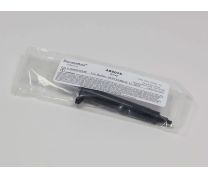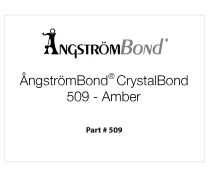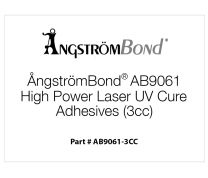Fiber Optic Center will be at Photonics West - and BICSI Winter.
Schedule your meeting with a member of the FOC team now
AngstromBond Epoxy and Adhesives
- REQUEST A SAMPLE
 ÅngströmBond® AB9112 MIL-SPEC Fiber Optic Epoxy, Room Temperature & Heat Cure (2.5g)
ÅngströmBond® AB9112 MIL-SPEC Fiber Optic Epoxy, Room Temperature & Heat Cure (2.5g)The ÅngströmBond® 9112 MIL-SPEC Epoxy is a blue, room temperature and heat curing fiber optic connec...
Part: AB9112-2.5G - REQUEST A SAMPLE
 ÅngströmBond® AB9123 High Temperature Epoxy, Heat Cure (2.5g)
ÅngströmBond® AB9123 High Temperature Epoxy, Heat Cure (2.5g)The ÅngströmBond® 9123 Epoxy is a very fast-curing, high-temperature fiber optic connector epoxy. Th...
Part: AB9123-2.5G - REQUEST A SAMPLE
 ÅngströmBond® AB9320 Clear Epoxy, Heat Cure (2.5g)
ÅngströmBond® AB9320 Clear Epoxy, Heat Cure (2.5g)The ÅngströmBond® 9320 Epoxy is a low stress, heat cured clear epoxy designed for terminating multim...
Part: AB9320CLR-2.5G - REQUEST A SAMPLE
 ÅngströmBond® AB9226 Fast Cure Clear Epoxy, Room Temperature Cure (2.5g)
ÅngströmBond® AB9226 Fast Cure Clear Epoxy, Room Temperature Cure (2.5g)The ÅngströmBond® AB9226 Clear Epoxy is a fast gelling, two component, general purpose, semi-rigid e...
Part: AB9226-2.5G  ÅngströmBond® AB9075 Flexible Optical Adhesive, UV Cure (3cc Syringe)
ÅngströmBond® AB9075 Flexible Optical Adhesive, UV Cure (3cc Syringe)The ÅngströmBond® AB9075 is a very flexible and clear adhesive, offering low viscosity. Designed for...
Part: AB9075-3CC ÅngströmBond® ÅnaeBond™ AB101 Fast Cure Anaerobic Adhesive (10ml Adhesive and 1.75oz Primer)
ÅngströmBond® ÅnaeBond™ AB101 Fast Cure Anaerobic Adhesive (10ml Adhesive and 1.75oz Primer)The ÅngströmBond® AnaeBond™ 101 is a single-component anaerobic adhesive that rapidly develops high ...
Part: AB101-10ML ÅngströmBond® AB9047 Optical Adhesive, UV Cure (3cc Syringe)
ÅngströmBond® AB9047 Optical Adhesive, UV Cure (3cc Syringe)The ÅngströmBond® AB9047 Optical Adhesive is a fast UV curing adhesive designed for optic applicatio...
Part: AB9047-3CC ÅngströmBond® AB9028MV High Tg Adhesive, UV Cure (3cc Syringe)
ÅngströmBond® AB9028MV High Tg Adhesive, UV Cure (3cc Syringe)The ÅngströmBond® AB9028MV is a medium viscosity, UV-cure adhesive with a very high glass transition...
Part: AB9028MV-3CCM ÅngströmBond® AB9028 High Tg Adhesive, UV Cure (3cc Syringe)
ÅngströmBond® AB9028 High Tg Adhesive, UV Cure (3cc Syringe)The ÅngströmBond® AB9028 UV Cure Optical Adhesive has a very high glass transition temperature. This...
Part: AB9028-3CC ÅngströmBond® AB9190 Low Viscosity Clear Epoxy, Room Temperature Cure (2.5g)
ÅngströmBond® AB9190 Low Viscosity Clear Epoxy, Room Temperature Cure (2.5g)The ÅngströmBond® 9190 Clear Epoxy is a very low viscosity, rigid epoxy system specially designed fo...
Part: AB9190-2.5G ÅngströmBond® CrystalBond™ 509 Temporary Mounting and Bonding Amber Adhesive
ÅngströmBond® CrystalBond™ 509 Temporary Mounting and Bonding Amber AdhesiveThe ÅngströmBond® CrystalBond™ 509 Temporary Mounting and Bonding Adhesive is designed for mounting ...
Part: 509- REQUEST A SAMPLE
 ÅngströmBond® AB9195 Flexible Epoxy, Room Temperature & Heat Cure (2.5g)
ÅngströmBond® AB9195 Flexible Epoxy, Room Temperature & Heat Cure (2.5g)The ÅngströmBond® AB9195 is a low viscosity, flexible adhesive designed for bonding and encapsulatin...
Part: AB9195-2.5G  ÅngströmBond® AB9018-1.62 High Refractive Index Adhesive, UV Cure (3cc Syringe)
ÅngströmBond® AB9018-1.62 High Refractive Index Adhesive, UV Cure (3cc Syringe)The ÅngströmBond® AB9018-162 High Refractive Index Adhesive is ideal for bonding glass, ceramics, an...
Part: AB9018-1.62-3CC ÅngströmBond® AB9079 Optical Adhesive, UV Cure (3cc Syringe)
ÅngströmBond® AB9079 Optical Adhesive, UV Cure (3cc Syringe)The ÅngströmBond® AB9079 is a medium viscosity, UV cure optical adhesive designed for bonding plasti...
Part: AB9079-3CCM ÅngströmBond® AB9061 High Power Laser Adhesive, UV Cure (3cc Syringe)
ÅngströmBond® AB9061 High Power Laser Adhesive, UV Cure (3cc Syringe)The ÅngströmBond® AB9061 High Power Laser Adhesive is a rigid, optically clear adhesive designed for...
Part: AB9061-3CC ÅngströmBond® AB9092 High Strength Optical Adhesive, UV Cure (3cc Syringe)
ÅngströmBond® AB9092 High Strength Optical Adhesive, UV Cure (3cc Syringe)The ÅngströmBond® AB9092 is a clear, rigid, medium viscosity, very high strength optical adhesive de...
Part: AB9092-3CCM ÅngströmBond® AB9018-1.62 High Refractive Index Adhesive, UV Cure (3cc Automatic Syringe)
ÅngströmBond® AB9018-1.62 High Refractive Index Adhesive, UV Cure (3cc Automatic Syringe)The ÅngströmBond® AB9018-162 High Refractive Index Adhesive is ideal for bonding glass, ceramics, an...
Part: AB9018-1.62-3CCA ÅngströmBond® AB9015M Low Refractive Index Adhesive, UV Cure (3cc Manual Syringe)
ÅngströmBond® AB9015M Low Refractive Index Adhesive, UV Cure (3cc Manual Syringe)The ÅngströmBond® AB9015M is a low refractive index optical adhesive with higher viscosities than ty...
Part: AB9015M-3CCM ÅngströmBond® AB9015P Low Refractive Index Adhesive, UV Cure (3cc Manual Syringe)
ÅngströmBond® AB9015P Low Refractive Index Adhesive, UV Cure (3cc Manual Syringe)The ÅngströmBond® AB9015P is a low refractive index optical adhesive with higher viscosities than ty...
Part: AB9015P-3CCM ÅngströmBond® AB9590 Thermally Conductive Black Epoxy, Room Temperature Cure (2.5g)
ÅngströmBond® AB9590 Thermally Conductive Black Epoxy, Room Temperature Cure (2.5g)The ÅngströmBond® AB9590 Thermally Conductive Epoxy is a two-component, high-performance epoxy adhes...
Part: AB9590-2.5G ÅngströmBond® AB9123EP High Temperature Epoxy, Heat Cure (4g)
ÅngströmBond® AB9123EP High Temperature Epoxy, Heat Cure (4g)The ÅngströmBond® AB9123EP is a very fast curing, high temperature fiber optic connector adhesive. T...
Part: AB9123EP-4G ÅngströmBond® AB9123EP High Temperature Epoxy, Heat Cure (8oz)
ÅngströmBond® AB9123EP High Temperature Epoxy, Heat Cure (8oz)The ÅngströmBond® AB9123EP is a very fast curing, high temperature fiber optic connector adhesive. T...
Part: AB9123EP-8OZ ÅngströmBond® AB9123 High Temperature Epoxy, Heat Cure (8oz)
ÅngströmBond® AB9123 High Temperature Epoxy, Heat Cure (8oz)The ÅngströmBond® 9123 is a very quick curing, high temperature fiber optic connector epoxy. This lo...
Part: AB9123-8OZ ÅngströmBond® AB9123 High Temperature Epoxy, Heat Cure, Pre-Mixed and Frozen (3cc Syringe)
ÅngströmBond® AB9123 High Temperature Epoxy, Heat Cure, Pre-Mixed and Frozen (3cc Syringe)The ÅngströmBond® 9123 is a very quick curing, high temperature fiber optic connector epoxy. This lo...
Part: AB9123-3CC
AngstromBond Epoxy and Adhesives
The Fiber Optic Center goal is to supply the best possible material for our customers’ application. By using ÅngströmBond® supplied material, you can minimize the typical adhesive related problems including but not limited to: Defective Epoxy, Wrong Epoxy for the Application, Incorrect Mix Ratio by Packager, Incorrect Mix Ratio by User, Expired Shelf Life, Use Beyond Working Life, Inappropriate Cure Schedule, Inadequate Packaging Affects Chemistry, Improper Storage (temp, light), Incomplete Dispensing into Substrate, Inappropriate or Defective Dispensing Equipment, Improper Cleaning of Epoxy Work Surfaces, Skin Reactions (Dermatitis).

